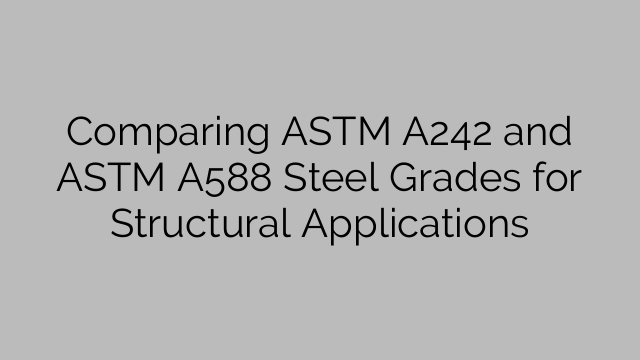When it comes to selecting the right steel grades for structural applications, it is important to consider factors such as corrosion resistance, mechanical properties, and cost. Two popular options in this regard are ASTM A242 and ASTM A588 steel grades. In this article, we will compare these two grades to help you make an informed decision for your next project.
ASTM A242 steel grade is a high-strength low-alloy steel (HSLA) that exhibits atmospheric corrosion resistance suitable for structural applications. It is mainly used in bridges and buildings due to its excellent strength-to-weight ratio and corrosion resistance properties. The steel contains copper, chromium, nickel, and other alloying elements that enhance its atmospheric corrosion resistance. As a result, it forms a protective oxide layer on the steel surface, preventing further corrosion.
On the other hand, ASTM A588 steel grade is a weathering steel that offers high strength and corrosion resistance. It is primarily used in construction applications, such as bridges, buildings, and towers. The main alloying elements in this steel grade are copper, chromium, and nickel. These elements provide the steel with superior weathering resistance by forming a protective patina over time. This patina not only slows down the corrosion process but also gives the steel a unique aesthetic appearance.
Now let’s compare these two steel grades based on their properties. ASTM A242 steel grade has a minimum yield strength of 50,000 psi and a minimum tensile strength of 70,000 psi. On the other hand, ASTM A588 steel grade has a minimum yield strength of 50,000 psi and a minimum tensile strength of 70,000 psi as well. Therefore, both grades have similar mechanical properties, making them suitable for structural applications. However, it is important to note that the actual strength may vary depending on the thickness of the steel plate.
In terms of corrosion resistance, ASTM A242 steel grade offers good resistance to atmospheric corrosion compared to carbon steel. However, ASTM A588 steel grade exhibits superior corrosion resistance due to the presence of alloying elements. Its weathering properties make it suitable for applications in harsh environmental conditions, such as coastal areas or regions with high levels of pollution. The weathering process of ASTM A588 steel allows it to develop a protective layer that extends its service life and reduces maintenance costs.
Lastly, cost is an important factor to consider. Both ASTM A242 and ASTM A588 steel grades are relatively cost-effective compared to other high-strength steel grades. However, the cost may vary depending on factors such as the size, quantity, and availability of the steel plates.
In conclusion, ASTM A242 and ASTM A588 steel grades are both suitable choices for structural applications. While ASTM A242 exhibits good corrosion resistance, ASTM A588 provides superior weathering properties. The selection between the two grades depends on the specific project requirements and environmental conditions. By considering the mechanical properties, corrosion resistance, and cost, you can make an informed decision to ensure the success of your structural project.

